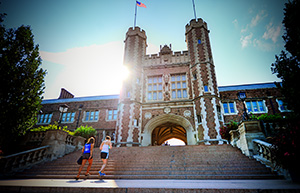Newly available figures show Washington University in St. Louis is beginning to show signs of growth in one important indicator of economic diversity among its student body — an increasing number of first-time, full-time students enrolling at the university are eligible for the Federal Pell Grant Program.
 The percentage of Pell-eligible students in the 2014-15 freshman class has climbed to an estimated 8 percent, up from 6 percent in 2013-14 and 5 percent in 2012-13. The number of Pell-eligible students has increased by more than half in the same time period, from 85 in 2012-13 and 97 in 2013-14 to an estimated 138 in 2014-15. The Pell Grant provides a small fraction of the total cost of attendance for low-income students, and the university provides the vast majority of support through its need-based aid program.
The percentage of Pell-eligible students in the 2014-15 freshman class has climbed to an estimated 8 percent, up from 6 percent in 2013-14 and 5 percent in 2012-13. The number of Pell-eligible students has increased by more than half in the same time period, from 85 in 2012-13 and 97 in 2013-14 to an estimated 138 in 2014-15. The Pell Grant provides a small fraction of the total cost of attendance for low-income students, and the university provides the vast majority of support through its need-based aid program.
“While we certainly recognize that there is still much work to be done, we are encouraged by this positive trend,” said Chancellor Mark S. Wrighton. “We remain deeply committed to providing full financial support for all students who need assistance. We will continue pushing forward in this area until we achieve our critical goal of increasing accessibility in order to create an even more economically diverse student body.”
The university’s approach to accessibility has three important components:
- Strengthening the pipeline of well-prepared students through initiatives such as the new College Prep Program, highlighted recently by the St. Louis Post-Dispatch, and the university-sponsored KIPP academies, high-performing charter schools serving low-income students in the St. Louis region;
- Making it possible for admitted students to attend, regardless of ability to pay, by increasing opportunities for scholarship support — the university’s current capital campaign includes a $400-million goal for financial aid — and through its no-loan program, which ensures freshmen from families with an annual income of less than $75,000 receive financial aid packages with no loans; and
- Empowering students once they arrive, through mentoring, stipends for internships, books and travel, and other personalized programs.
“There is no way around it — we need to do better,” said H. Holden Thorp, PhD, provost and executive vice chancellor for academic affairs. “Not only is making higher education more accessible the right thing to do; our success as a university greatly depends on bringing together the right mix of bright and talented people from a wide range of backgrounds. Only by expanding our perspectives and points of view will we truly achieve the diversity of thought and opinion that defines great institutions like Washington University.”
Federal Pell Grants are post-secondary educational grants sponsored by the U.S. Department of Education to help undergraduates from low-income families. Unlike loans, Pell Grants do not have to be repaid. Approximately 5.4 million full-time and part-time college and vocational school students receive Pell Grants nationwide each year.